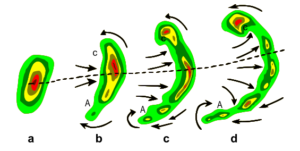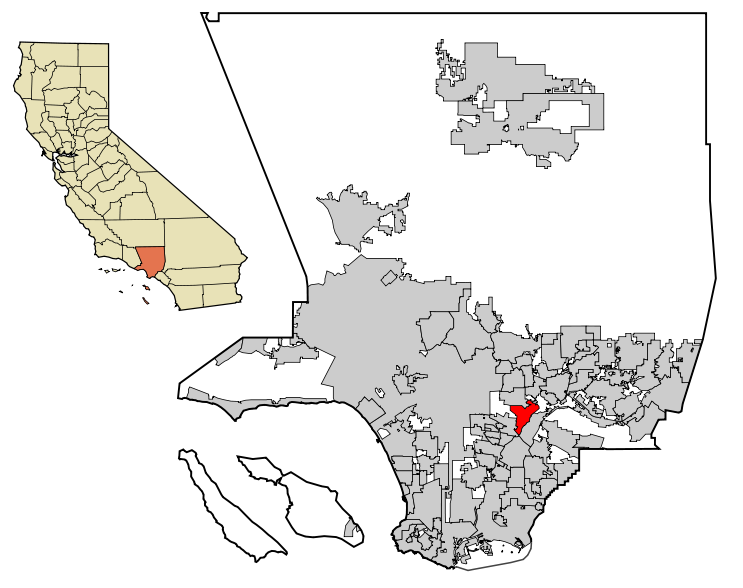A tornado struck Los Angeles County in California, USA, on Wednesday March 22, 2023, causing minor injuries to one person and damaging a minimum of 17 buildings, as reported by the National Weather Service.
With peak wind speeds of 110 miles per hour (177 kilometers per hour), the EF-1 tornado first touched down in Montebello, making it the most powerful twister to impact the county since 1983.
As the tornado moved into Los Angeles, it wreaked havoc on vehicles, shattered skylights, collapsed a building’s roof, split a utility pole, and uprooted a large pine tree.
In a separate event on Tuesday, an EF-0 tornado hit Carpinteria, California, in Santa Barbara County, damaging 25 mobile homes and causing minor harm to trees in a nearby cemetery, according to National Weather Service personnel.
Tornadoes are a rare occurrence in California, with the state experiencing an annual average of fewer than 10 to 11 twisters. The National Oceanic and Atmospheric Administration stated that tornadoes in California seldom gain strength or last long.
CNN reported that in recent months, the state has faced flooding and at least 12 atmospheric rivers, which have brought additional flooding and hurricane-force winds. A storm in the San Francisco area on Tuesday resulted in the deaths of at least five people, the falling of over 700 trees and limbs, and the loss of power lines. The city also received reports of high-rise buildings shedding glass and other debris.
How do Tornadoes Form?
Tornadoes form under specific atmospheric conditions, typically during severe thunderstorms. The essential ingredients for tornado formation include:
- Warm, moist air near the surface: This creates instability in the atmosphere, as the warm air rises and cools, condensing into clouds and precipitation.
- Cooler, drier air above: This causes a sharp temperature gradient and further enhances atmospheric instability.
- Wind shear: A change in wind speed and/or direction with altitude creates a horizontal spinning effect in the lower atmosphere.
- Updraft: As the warm air rises, it tilts the horizontal rotation into a vertical orientation, creating a rotating column of air.
- Thunderstorm: A strong thunderstorm, usually a supercell, provides the necessary updraft and rotation to develop the tornado.

Tornadoes are more likely to form in regions with frequent severe thunderstorms, such as the United States’ Tornado Alley, which stretches across parts of Texas, Oklahoma, Kansas, Nebraska, and South Dakota. However, tornadoes can occur in other areas as well, including California.
While tornadoes are relatively rare in California compared to Tornado Alley, they can still form under the right conditions. The state experiences an average of fewer than 10 to 11 tornadoes per year. California tornadoes are usually weaker and short-lived compared to those in Tornado Alley, but they can still cause damage and pose threats to public safety.
In general, tornadoes can form in any state or region where the necessary atmospheric conditions are present. It is essential to stay informed about local weather conditions and follow safety guidelines if a tornado warning is issued for your area.
The tornado that touched down in Montebello, Los Angeles County, was classified as an EF-1 on the Enhanced Fujita scale, with peak wind speeds reaching 110 miles per hour (177 kilometers per hour).
In Carpinteria, Santa Barbara County, the tornado was rated as an EF-0. The EF-0 classification indicates relatively weaker tornadoes with wind speeds between 65-85 miles per hour (105-137 kilometers per hour), causing minor damage.
Strongest Tornadoes on Record
The strongest tornadoes on record are rated as EF-5 on the Enhanced Fujita scale, which categorizes tornadoes based on the intensity of the damage they cause. EF-5 tornadoes have estimated wind speeds exceeding 200 miles per hour (322 kilometers per hour) and can cause devastating damage. Some of the most notable EF-5 tornadoes in history include:
- The Tri-State Tornado (March 18, 1925): This deadly tornado remains the deadliest in U.S. history, causing 695 fatalities as it tore through Missouri, Illinois, and Indiana. It traveled over 219 miles (352 km), making it the longest single tornado track ever recorded.
- The Moore, Oklahoma Tornado (May 3, 1999): Also known as the Bridge Creek-Moore tornado, this EF-5 tornado caused 36 fatalities and over $1 billion in damages. It had the highest recorded wind speed at the time, at 301 miles per hour (484 km/h).
- The Joplin, Missouri Tornado (May 22, 2011): This EF-5 tornado devastated the city of Joplin, causing 158 fatalities and over $2.8 billion in damages, making it one of the costliest tornadoes in U.S. history.
- The El Reno, Oklahoma Tornado (May 31, 2013): Though initially rated as an EF-3, further analysis of the data revealed it was an EF-5 tornado. It had a record width of 2.6 miles (4.2 km) but fortunately caused fewer fatalities (8) than some other EF-5 tornadoes. However, it was responsible for the deaths of three experienced storm chasers, highlighting the dangers associated with tornado research.

